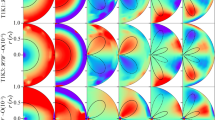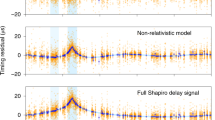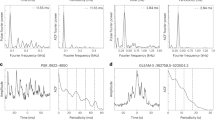Abstract
Neutron stars are unique cosmic laboratories in which fundamental physics can be probed in extreme conditions not accessible to terrestrial experiments. In particular, the precise timing of rotating magnetized neutron stars (pulsars) reveals sudden jumps in rotational frequency in these otherwise steadily spinning-down objects. These ‘glitches’ are thought to be due to the presence of a superfluid component in the star, and offer a unique glimpse into the interior physics of neutron stars. In this paper we propose an innovative method to constrain the mass of glitching pulsars, using observations of the maximum glitch observed in a star, together with state-of-the-art microphysical models of the pinning interaction between superfluid vortices and ions in the crust. We study the properties of a physically consistent angular momentum reservoir of pinned vorticity, and we find a general inverse relation between the size of the maximum glitch and the pulsar mass. We are then able to estimate the mass of all the observed glitchers that have displayed at least two large events. Our procedure will allow current and future observations of glitching pulsars to constrain not only the physics of glitch models but also the superfluid properties of dense hadronic matter in neutron star interiors.
This is a preview of subscription content, access via your institution
Access options
Access Nature and 54 other Nature Portfolio journals
Get Nature+, our best-value online-access subscription
$29.99 / 30 days
cancel any time
Subscribe to this journal
Receive 12 digital issues and online access to articles
$119.00 per year
only $9.92 per issue
Buy this article
- Purchase on Springer Link
- Instant access to full article PDF
Prices may be subject to local taxes which are calculated during checkout





Similar content being viewed by others
References
Haskell, B. et al. Detecting gravitational waves from mountains on neutron stars in the advanced detector era. Mon. Not. R. Astron. Soc. 450, 2393–2403 (2015).
Abbott, B. P. et al. Comprehensive all-sky search for periodic gravitational waves in the sixth science run LIGO data. Phys. Rev. D 94, 042002 (2016).
Manchester, R. N. Pulsars and gravity. Int. J. Mod. Phys. D 24, 1530018 (2015).
Hobbs, G. et al. Development of a pulsar-based timescale. Mon. Not. R. Astron. Soc. 427, 2780–2787 (2012).
Sauls, J. A. in Timing Neutron Stars (eds Ogelman, H. & van den Heuvel, E. P. J. ) NATO ASI Series C, Vol. 262, 457–490 (Kluwer Academic, 1989).
Anderson, P. W. & Itoh, N. Pulsar glitches and restlessness as a hard superfluidity phenomenon. Nature 256, 25–27 (1975).
Chamel, N. & Haensel, P. Physics of neutron star crusts. Living Rev. Relat. 11, 10–191 (2008).
Haskell, B. & Melatos, A. Models of pulsar glitches. Int. J. Mod. Phys. D 24, 1530008 (2015).
Hall, H. E. & Vinen, W. F. The rotation of liquid helium II. II. The theory of mutual friction in uniformly rotating helium II. Proc. R. Soc. A 238, 215–234 (1956).
Mendell, G. Superfluid hydrodynamics in rotating neutron stars. I. Nondissipative equations. II. Dissipative effects. Astrophys. J. 380, 515–540 (1991)
Carter, B. & Langlois, D. Relativistic models for superconducting superfluid mixtures. Nucl. Phys. B 531, 478–504 (1998).
Prix, R., Comer, G. L. & Andersson, N. Slowly rotating superfluid Newtonian neutron star model with entrainment. Astron. Astrophys. 381, 178–196 (2002).
Andersson, N. & Comer, G. L. A flux-conservative formalism for convective and dissipative multi-fluid systems, with application to Newtonian superfluid neutron stars. Class. Quant. Grav. 23, 5505–5529 (2006).
Andersson, N. & Comer, G. L. Relativistic fluid dynamics: physics for many different scales. Living Rev. Relat. 10, 1–83 (2007).
Haskell, B., Pizzochero, P. M. & Sidery, T. Modelling pulsar glitches with realistic pinning forces: a hydrodynamical approach. Mon. Not. R. Astron. Soc. 420, 658–671 (2012).
Howitt, G., Haskell, B. & Melatos, A. Hydrodynamic simulations of pulsar glitch recovery, Mon. Not. R. Astron. Soc. 460, 1201–1213 (2016).
Sourie, A., Chamel, N., Novak, J. & Oertel, M. Global numerical simulations of the rise of vortex-mediated pulsar glitches in full general relativity. Mon. Not. R. Astron. Soc. 464, 4641–4657 (2016).
Link, B., Epstein, R. I. & Lattimer, J. M. Pulsar constraints on neutron star structure and equation of state. Phys. Rev. Lett. 83, 3362–3365 (1999).
Andersson, N., Glampedakis, K., Ho, W. C. G. & Espinoza, C. M. Pulsar glitches: the crust is not enough. Phys. Rev. Lett. 109, 241103 (2012).
Chamel, N. Crustal entrainment and pulsar glitches. Phys. Rev. Lett. 110, 011101 (2013).
Ho, W. C. G., Espinoza, C. M., Antonopoulou, D. & Andersson, N. Pinning down the superfluid and measuring masses using pulsar glitches. Science Adv. 1, e1500578 (2015).
Newton, W. G., Berger, S. & Haskell, B. Observational constraints on neutron star crust–core coupling during glitches. Mon. Not. R. Astron. Soc. 454, 4400–4410 (2015).
Delsate, T. et al. Giant pulsar glitches and the inertia of neutron-star crusts. Phys. Rev. D 94, 023008 (2016).
Seveso, S., Pizzochero, P. M., Grill, F. & Haskell, B. Mesoscopic pinning forces in neutron star crusts, Mon. Not. R. Astron. Soc. 455, 3952–3967 (2016).
Antonelli, M. & Pizzochero, P. M. Axially symmetric equations for differential pulsar rotation with superfluid entrainment. Mon. Not. R. Astron. Soc. 464, 721–733 (2017).
Alpar, M. A., Anderson, P. W., Pines, D. & Shaham, J. Giant glitches and pinned vorticity in the VELA and other pulsars. Astrophys. J. Lett. 249, L29–L33 (1981).
Andreev, A. F. & Bashkin, E. P. Three velocity hydrodynamics of superfluid solutions. Sov. Phys. JETP 42, 164–167 (1976).
Chamel, N. Neutron conduction in the inner crust of a neutron star in the framework of the band theory of solids. Phys. Rev. C 85, 035801 (2012).
Chamel, N. & Haensel, P. Entrainment parameters in a cold superfluid neutron star core. Phys. Rev. C 73, 045802 (2006).
Andersson, N., Sidery, T. & Comer, G. L. Superfluid neutron star turbulence. Mon. Not. R. Astron. Soc. 381, 747–756 (2007).
Douchin, F. & Haensel, P. A unified equation of state of dense matter and neutron star structure. Astron. Astrophys. 380, 151–167 (2001).
Goriely, S., Chamel, N. & Pearson, J. M. Further explorations of Skyrme–Hartree–Fock–Bogoliubov mass formulas. XII. Stiffness and stability of neutron-star matter. Phys. Rev. C 82, 035804 (2010).
Dodson, R. G., Lewis, D. & McCulloch, P. Two decades of pulsar timing of Vela. Astrophys. Space Sci. 308, 585–589 (2007).
Melatos, A., Peralta, C. & Wyithe, J. S. B. Avalanche dynamics of radio pulsar glitches. Astrophys. J. 672, 1103–1118 (2008).
Espinoza, C. M., Lyne, A. G., Stappers, B. W. & Kramer, M. A study of 315 glitches in the rotation of 102 pulsars. Mon. Not. R. Astron. Soc. 4, 1679–1704 (2011).
Haskell, B. Effect of superfluidity on pulsar glitch statistics. Mon. Not. R. Astron. Soc. Lett. 461, L77–L81 (2016).
Ozel, F. & Freire, P. Masses, radii, and the equation of state of neutron stars. Annu. Rev. Astron. Astrophys. 54, 401–440 (2016).
Lyne, A.G. The binary nature of PSR J2032+4127. Mon. Not. R. Astron. Soc. 451, 581–587 (2015).
Demorest, P. B., Pennucci, T., Ransom, S. M., Roberts, M. S. E. & Hessels, J. W. T. A two-solar-mass neutron star measured using Shapiro delay. Nature 476, 1081–1083 (2010).
Lattimer, J. M. & Steiner, A. W. Neutron star masses and radii from quiescent low-mass X-ray binaries. Astrophys. J. 784, 123–137 (2014).
Easson, I. Postglitch behavior of the plasma inside neutron stars. Astrophys. J. 228, 257–267 (1979).
Epstein, R. I. & Baym, G. Vortex pinning in neutron stars. Astrophys. J. 328, 680–690 (1988).
Donati, P. & Pizzochero, P. M. Realistic energies for vortex pinning in intermediate-density neutron star matter. Phys. Lett. B 640, 74–81 (2006).
Wlazłowski, G., Sekizawa, K., Magierski, P., Bulgac, A. & Forbes, M. Vortex pinning and dynamics in the neutron star crust. Phys. Rev. Lett. 117, 232701 (2016).
Taranto, G., Burgio, G. F. & Schulze, H.-J. Cassiopeia A and direct URCA cooling. Mon. Not. R. Astron. Soc. 456, 1451–1458 (2015).
Heinke, C. O. & Ho, W. C. G. Direct observation of the cooling of the Cassiopeia A neutron star. Astrophys. J. Lett. 719, L167–L171 (2010).
Elshamouty, K. J. et al. Measuring the cooling of the neutron star in Cassiopeia A with all Chandra X-ray Observatory detectors. Astrophys. J. 777, 22 (2013).
Posselt, B., Pavlov, G. G., Suleimanov, V. & Kargaltsev, O. New constraints on the cooling of the central compact object in Cas A. Astrophys. J. 779, 186–203 (2013).
Ruderman, M. Crust-breaking by neutron superfluids and the Vela pulsar glitches. Astrophys. J. 203, 213–222 (1976).
Pizzochero, P. M. Angular momentum transfer in Vela-like pulsar glitches. Astrophys. J. Lett. 743, L20–L25 (2011).
Gugercinoglu, E. & Alpar, M. A. Vortex creep against toroidal flux lines, crustal entrainment, and pulsar glitches. Astrophys. J. Lett. 788, L11–L15 (2014).
Link, B. Instability of superfluid flow in the neutron star core. Mon. Not. R. Astron. Soc. 421, 2682–2691 (2012).
Haskell, B., Pizzochero, P. M. & Seveso, S. Investigating superconductivity in neutron star interiors with glitch models. Astrophys. J. Lett. 764, L25–L29 (2013).
Acknowledgements
Partial support comes from NewCompStar, COST ActionMP1304. B.H. is supported by a Marie Curie Individual Fellowship, project 702713 Super-DENSE and NCN grant 2015/18/E/ST9/00577.
Author information
Authors and Affiliations
Contributions
P.M.P. led the research, contributed to developing the model and wrote the final manuscript. M.A. contributed to developing the model, selected the observational data, performed the calculations and contributed to the initial manuscript. B.H. contributed to the model and to the initial manuscript. S.S. contributed to the model and selected the observational data.
Corresponding author
Ethics declarations
Competing interests
The authors declare no competing financial interests.
Rights and permissions
About this article
Cite this article
Pizzochero, P., Antonelli, M., Haskell, B. et al. Constraints on pulsar masses from the maximum observed glitch. Nat Astron 1, 0134 (2017). https://doi.org/10.1038/s41550-017-0134
Received:
Accepted:
Published:
DOI: https://doi.org/10.1038/s41550-017-0134
This article is cited by
-
A very large slow glitch in PSR J1602–5100
Astrophysics and Space Science (2019)
-
Entrainment in Superfluid Neutron-Star Crusts: Hydrodynamic Description and Microscopic Origin
Journal of Low Temperature Physics (2017)
-
Superfluidity and Superconductivity in Neutron Stars
Journal of Astrophysics and Astronomy (2017)



